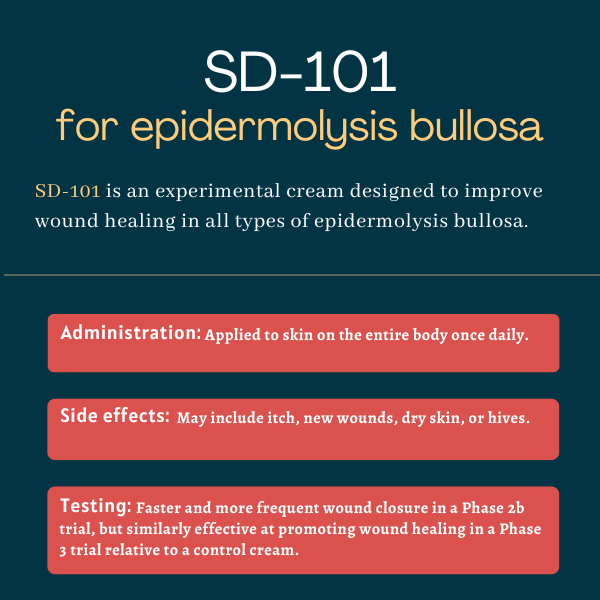SD-101 for epidermolysis bullosa
Last updated June 18, 2025, by Marisa Wexler, MS

What is SD-101 for epidermolysis bullosa?
SD-101 is an experimental cream that is being investigated as a whole-body treatment to promote wound healing in people with all forms of epidermolysis bullosa (EB). This rare disease is characterized by fragile skin that easily tears and blisters with minor friction, rubbing, heat, and everyday tasks, leading to open wounds. SD-101 contains 6% allantoin, a compound that’s thought to foster wound healing. Further reported benefits include anti-inflammatory and skin shedding effects, killing bacteria and removing dead tissue.
Paradigm Therapeutics — which in 2023 acquired rights to SD-101 in a deal with its former developer Amicus Therapeutics — has announced plans to seek U.S. Food and Drug Administration (FDA) approval of SD-101. The company is expected to submit the application in late 2025 and sell the cream under the name Zorblisa.
Therapy snapshot
| Treatment name: | SD-101 |
| Administration: | Cream applied to the whole body |
| Clinical testing: | A Phase 3 trial did not meet its main goals |
How will SD-101 be administered?
SD-101 is a cream designed to be applied to the skin. In clinical trials, it was applied once daily across the whole body.

SD-101 in clinical trials
SD-101 has been tested in a Phase 2b trial (NCT02014376) in 48 participants and in a Phase 3 trial called ESSENCE (NCT02384460) that enrolled 169 people. Both these studies involved patients with various types of EB (simplex, recessive dystrophic, or junctional intermediate EB) and tested once-daily application of SD-101 or a control cream (with no allantoin) over the entire body for 90 days, or about three months.
- The Phase 2b trial primarily aimed to test whether SD-101 led to a higher proportion of complete wound closure within one month. Results showed a high proportion with SD-101 containing 6% allantoin that persisted during the trial’s three months. The group treated with this SD-101 formulation (3% allantoin was also tested) also showed faster wound closure. An extension study then showed that SD-101 at 6% allantoin led to a decreased body surface area affected by wounds or lesions over 12 months.
- The ESSENCE study hoped to show that SD-101 with 6% allantoin was better than the control cream at promoting wound healing, but results showed no difference in time to wound closure, no difference in the proportion of patients with full wound closure at the end of the trial, and no differences in patient-reported measures of pain or itching. Trends toward faster wound healing with SD-101 were observed in patients aged 2 to 11 years and those with total-body wound burden of at least 5% at the study’s start.
A subsequent analysis argued that the lack of differences between SD-101 and the control cream in ESSENCE occurred not because SD-101 doesn’t work, but because the control cream was more effective than expected. The company noted that the control cream contained substances that may promote healing such as lanolin oil and cod liver oil.
SD-101 side effects
In the clinical trials conducted to date, common side effects of SD-101 included:
- itching
- new wounds or blisters
- hives
- dry skin
- common cold
- fever
- application site pain.
Epidermolysis Bullosa News is strictly a news and information website about the disease. It does not provide medical advice, diagnosis, or treatment. This content is not intended to be a substitute for professional medical advice, diagnosis, or treatment. Always seek the advice of your physician or other qualified health provider with any questions you may have regarding a medical condition. Never disregard professional medical advice or delay in seeking it because of something you have read on this website.
Recent Posts
- Repurposing existing medicines may offer faster route to new EB treatment
- Approved psoriasis drug apremilast to be tested in severe EBS patients
- An unbreakable sibling bond that surprisingly resulted from EB
- Scientists track RDEB’s genetic cause back to Sephardic ancestors
- New stem cell findings point to better healing in mouse model